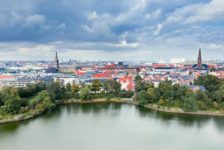20-July-2015 The Latest News in Landscape Architecture 2015 is sponsored by ZinCo – Life on Green Roofs – Ecological and Economical Green Roofs, worldwide. In this week’s Latest News in Landscape Architecture we announce the opening of Riverfront Park in Nashville, highlight two new Dutch elevated parks, and feature a unique highway strictly for bees in Norway! Did you know that last year the United States lost 40% of its honeybee population? In The News This Week:
- Five Things to Know About Riverfront Park
- Oslo Builds Bee Highway To Save Precious Pollinators
- Crowdsourced Infrastructure: Dutch Architects ZUS Complete A Self-Initiated Footbridge
- How 5 International Cities Are Going Car-Free
- Jury Announced for Landscape Institute’s Paxton Park Design Competition
- Paleisbrug by Benthem Crouwel is a Bridge, Park and Solar Collector in One
(Click the headline for the full story)
Latest News in Landscape Architecture 2015
- Five Things to Know About Riverfront Park: Nashville Business Journal
The 11-acre park and amphitheater known as Riverfront Park will open July 30th and serve as the city’s “front porch” featuring elements for relaxation, recreation, and entertainment. Designed by Hawkins Partners, Smith Gee Studio, and a renowned team of performance design professionals including Hodgetts+Fung, Jaffe Holden, and Schuler Shook —the park has been long-awaited. With a rich selection and quantity of plants, the park will earn Level 1 arboretum status (publicly accessible sites with at least 25 species of woody plants). “This site is the last great vestige of open space in downtown Nashville, and I can’t think of a better use for such beautiful green space than a world-class park, coupled with a spectacular performance venue to showcase all that Music City has to offer,” Mayor Dean said. Related Article: 10 Awesome Riverbank Projects

Riverfront Park from Seigenthaler Bridge
Image credit: Brian Phelps
- Oslo Builds Bee Highway To Save Precious Pollinators: Popular Science
The fact that bees are struggling for survival is no minor dilemma. Each year our winged friends help pollinate crops to a value of $15 billion dollars in the United States—without them we simply would not have food! While many factors such as climate change, pesticide use, disease, and habitat loss are to blame for their decline—this issue is not unique to the US as other countries are having the same problem. Known for its stunning scenery and coastal landscapes, now the Scandinavian Peninsula is home to one of the world’s first “bee highways”. Created through a series of government-funded green roofs and private gardens—the network will allow bees to safely traverse the country’s capital city, Oslo. “We are constantly reshaping our environment to meet our needs, forgetting that other species also live in it,” Agnes Lyche Melvaer, head of an Oslo-based environmental group supporting urban bees Related Article: The Global Collapse in Bee Populations WATCH: Norway Builds First Known ‘Bee Highway’
- Crowdsourced Infrastructure: Dutch Architects ZUS Complete A Self-Initiated Footbridge: Architect’s Newspaper
Since the opening of the Delftsehof nightlife area and two nearby parks, many locals complained that the districts needed to be connected. They got their wish. In what began through the 2012 Architecture Biënnale Rotterdam (IABR), the site became a “test-site” consisting of 18 interventions. By way of crowd-funding by the design practice of Zones Urbaines Sensibles (ZUS) and a strong public presence the residents now have a tremendous footbridge, which has already (and will continue) to serve as a catalyst for growth. Related Article: Top 10 Pedestrian Bridges
- Jury Announced for Landscape Institute’s Paxton Park Design Competition: Horticulture Week
To celebrate Joseph Paxton’s life and legacy, the Landscape Institute North West Branch and the MMU Landscape Architecture Department have partnered to launch a design ideas competition to create a 21st-century public park. Featuring a rather touted shortlist judging panel, including James Corner (most famous for New York’s High Line)—ultimately an award of £1000 will be presented to the winning entries and those will be part of an exhibition at MMU in October 2015.
- How 5 International Cities Are Going Car-Free: Mother Nature Network
Many of the large and mid-size metropolises are encouraging car-free lifestyles by establishing car-free zones in city centers, increasing the number of bike facilities, connecting green spaces, and improving public transit. From Madrid’s smart meter parking program (which senses gas guzzlers and makes vehicle owners pay additional fees), to Hamburg’s ambitious plans to transform 40% of the city to car-free zones by 2034, and Copenhagen’s 390 kilometers (about 242 miles) of bike infrastructure—these are just a few cities where a car is not needed. Related Article: Top 10 Walkable Cities WATCH: Hamburg am Alster
While the multi-use elevated park, which also features a pedestrian and bicycle bridge along with plants, seating and a solar collector, opened in May 2015, however it’s first beginning to get international acclaim. Designed by the Dutch architectural practice of Benthem Crouwel Architekten, the project serves as a 250 meter-long link across the railway track between the historic centre of ‘s-Hertogenbosch and Paleiskwartier. Borrowing inspiration from the High Line, the design team commissioned Piet Oudolf to develop the planting scheme and it features three characteristic zones. Related Article: The Flying Parks—From the Highline in New York to the Promenade Plantée in Paris! WATCH: Paleisbrug Den Bosch (Netherlands)
–
Latest News in Landscape Architecture 2015
News report by Brett Lezon
The Latest News in Landscape Architecture was brought to you by Landscape Architects Network and our sponsors ZinCo – Life on Green Roofs – Ecological and Economical Green Roofs, worldwide.
For all of the hottest news continue to follow us on Facebook and Twitter. Have news to share? Send to office@landarchs.com
Published in Blog







